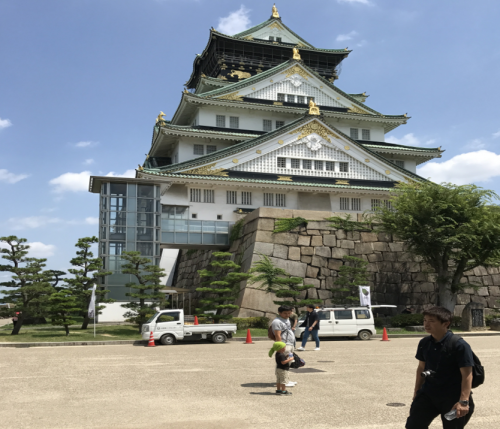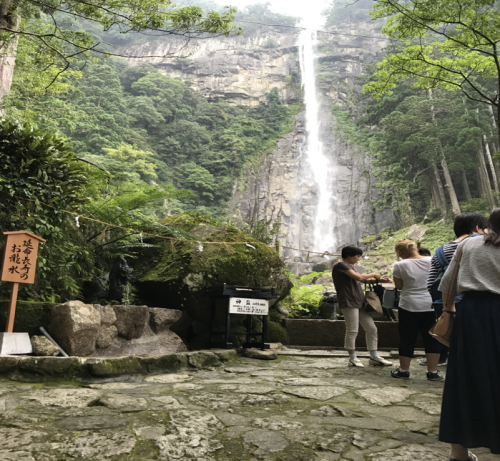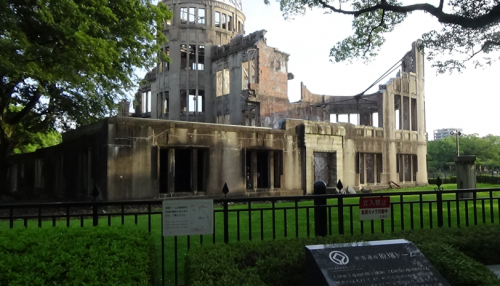Sarah Martin, Manager, Lending Services
In July, Agnes and her husband spent 10 days travelling around Japan. Here is a condensed version of their trip!

First stop:
Osaka (大阪市) is a designated city in the Kansai region of Japan. The second largest metropolitan area in Japan and among the largest in the world with over 19 million inhabitants. Situated at the mouth of the Yodo River on Osaka Bay. Historically a merchant city, Osaka has also been known as the "nation's kitchen" and served as a center for the rice trade during the Edo period.

Osaka Castle in Osaka.
Second stop:
Nachi Falls (那智滝) in Nachikatsuura, Wakayama Prefecture is one of the best-known waterfalls in Japan. With a drop of 133 meters (and 13 meters wide), it is the country's tallest water fall with single uninterrupted drop.
We were fortunate to experience Nachi Fire Festival which is one of the three largest fire festivals in Japan, is staged in the Kumano mountains of Wakayama Prefecture, an area registered as a World Heritage Site. Twelve huge 50-kg pine torches waved around so close to portable shrines that it appears as if they are about to be scorched. The enormous pine torches represent the 12 deities dwelling in Kumano as well as the 12 months of the year. The portable shrines, which are produced in the image of the sacred falls, are filled with the spirits of the 12 gods, and then purified by the fire of the pine torches. Vitality is enhanced through these sacred rituals, which is one important objective of this festival.

Nachi Falls, Nachikatsuura, Wakayama Prefecture.

Festival of Fire at Nachi Falls.
Third stop:
Kyoto (京都) was the capital of Japan for over a millennium, and carries a reputation as its most beautiful city. In 1994, 17 historic sites were inscribed on UNESCO's World Heritage List under the group designation Historic Monuments of Ancient Kyoto. Fourteen of the listed sites are in Kyoto itself.

Torii gates at Fushimi Inari Shrine, Kyoto.

Kyoto Sagano bamboo forest.
Fourth stop:
Miyajima (宮島) is a small island less than an hour outside the city of Hiroshima. One of the best scenic spots in Japan, it has long been regarded as an Island of Gods on the beautiful Seto Inland Sea. It is most famous for its giant torii gate, which at high tide seems to float on the water. The sight is ranked as one of Japan's three best views. There are wild deer on the island that have become accustomed to people. In the day the deer wander around the same sites as the tourists, and in the evening they sleep along the walking paths.

Torii gate at Miyajima, in the Sea of Japan.
Fifth stop:
Hiroshima (広島市) is the capital of Hiroshima Prefecture and the largest city in the Chūgoku region of western Honshu - the largest island of Japan. Hiroshima is best known as the first city in history to be targeted by a nuclear weapon when the United States Army Air Forces (USAAF) dropped an atomic bomb on the city at 8:15 a.m. on August 6, 1945, near the end of World War II directly killing an estimated 70,000 people. Injury and radiation brought the total number of deaths to 150,000. The Hiroshima Peace Memorial commonly called the Atomic Bomb Dome or A-Bomb Dome is part of the Hiroshima Peace Memorial Park in Hiroshima and was designated a UNESCO World Heritage Site in 1996. The ruin serves as a memorial to the people who were killed in the atomic bombing.

A-Bomb Dome at the Hiroshima Peace Memorial Park.

Children's Peace Monument in Hiroshima Peace Memorial Park.
Sixth stop:
Tokyo is the capital of Japan and one of its 47 prefectures. The Greater Tokyo Area is the most populous metropolitan area in the world. It is the seat of the Emperor of Japan and the Japanese government. Asakusa (浅草) is a district in Taitō, Tokyo, Japan, famous for the Sensō-ji, a Buddhist temple dedicated to the bodhisattva Kannon built in the 7th century. Asakusa was developed as an entertainment district during the Edo period and one of Tokyo's districts, where an atmosphere of the Tokyo past decades survives. There are several other temples in Asakusa, as well as various festivals, such as the Sanja Matsuri.

Sensoji Temple in Tokyo.
If you enjoy mountain scenery, tranquil gardens, authentic traditional districts, ancient historical sites, seafood, and fast trains (Shinkansen) Japan is the place to go.

Reclining Buddha at Nanzoin Temple in Fukuoka.




